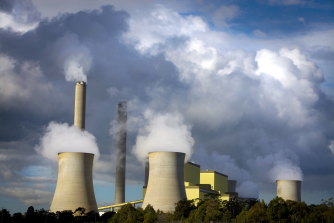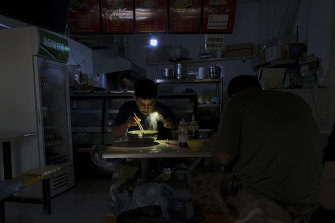Our energy crisis has been a decade in the making. Don’t expect a quick fix
June 16, 2022The chaos and dysfunction in the national electricity market this week flows from the collision of a number of unexpected events with long-term vulnerabilities. It was, however, eminently foreseeable and therefore an indictment on policymakers over a very long period.
There was a series of largely unrelated issues that led to this week’s unprecedented decision by the Australian Energy Market Operator to suspend the spot market for wholesale electricity and take control of the generation sector, enabling it to decide who should supply power into the grid and when.
In taking control of the generators AEOM will now compensate the generators for any losses, a cost that will inevitably be borne by consumers.Credit:Fairfax Media
The catalyst for the invoking of AEOM’s emergency powers was its own decision to impose a cap on prices of $300/MWh after spot prices skyrocketed.
Gas-fired generators, and some coal-fired plants (which need prices above $400/MWh to break even) withdrew from the market, creating a shortfall of supply relative to demand, and forcing AEOM’s hand.
In taking control of supply, AEOM will now compensate the generators for any losses, a cost that will inevitably be borne by consumers.
That might describe the events of this week but it doesn’t explain why they happened. The answer lies in a complex confluence of events, here and offshore, overlaid on some long term structural developments within the market.
Globally, pandemic-reduced investment in oil and gas production; a surge in demand for energy as much of the world has emerged from the worst of the pandemic and, more recently, Europe’s desperate efforts to secure new sources of supply after Russia’s invasion of Ukraine have combined to ignite a scramble for oil, coal and gas – gas in particular – that has sent prices soaring.
Locally, about a quarter of the capacity of Australia’s east coast coal-fired generators has been offline for either planned or unplanned maintenance.
At the same time, the coal-fired generators that supply more than half the east coast’s electricity have been hit by the higher cost of coal (the black coal used in NSW and Queensland is priced by the global market) and supply interruptions generated by the recent floods in those states.
And then there has been the sudden and intense cold snap across the east coast.
It is no surprise that the coal-fired generators are experiencing reliability issues. The fleet is diminishing and ageing and, with the accelerating impact of renewable sources on the grid and the economics of generation and hardening commitments to more ambitious emissions reduction targets there is no incentive for the plants’ owners to invest heavily in their reliability.
AEMO has projected that two-thirds of Australia’s coal generation capacity will disappear this decade. At the rate at which generators have been bringing forward the dates of their plants’ closures, that may be conservative.
The east coast grid was built for and around the giant coal-fired plants, with gas-fired generators supplementing their baseload power with peaking plants. It wasn’t designed for the influx of renewable energy that now accounts for around a third – and has momentarily supplied more than 60 per cent — of the energy in the grid.
Renewables aren’t as reliable as coal and gas-fired generators unless supported by battery storage on a scale vastly greater than is in place today but they produce energy at essentially no marginal cost. That has undermined the role and economics of coal-fired plants that are capital-intensive and, relative to renewables, have far higher operating costs.
The economic pressures, even without a hard emissions reduction target – in the new Labor government’s case, 43 per cent from a 2005 baseline by 2030 – have ensured the demise of the coal-fired sector while (along with the now-delayed construction of Snowy 2.0) deterring investment in the new gas-fired plants required to ensure a smooth transition to a green energy future.
So, there are significant structural shortcomings in a grid that wasn’t built to handle decentralised generation and the traditional sources of reliable energy are being forced out of the market even as their own input costs are soaring and their access to coal and gas is being throttled by the emissions targets and green activism.
Coal is off limits in any discussions about increased generation and, if the Greens and “teals” had their way, gas would be too. Nevertheless, more gas for both electricity and household and industrial uses is essential if the current crisis isn’t to be a preview of an unpalatable future.
There’s been a lot of recent discussion about domestic gas reservation and, in the wake of a recent UK announcement of a windfall profits tax on gas producers, similar tax imposts here as a response to the supply predicament.
Australia is one of the top three gas producers in the world, shipping about 80 million tonnes of LNG from the giant fields off the West Australian coast and the coal seam gas reserves in Queensland and South Australia each year.
The world is feeling the energy crunch with pandemic-reduced investment in oil and gas production, a surge in demand for energy and Europe’s desperate efforts to secure new sources of supply after Russia’s invasion of Ukraine combining to send prices soaring.Credit:AP
Most of that gas, more than 80 per cent in the case of the Queensland LNG plants, is sold under long term contracts at prices linked to an oil price that has been extremely volatile in recent years – in the past two years or so it has been as low as $US21 a barrel (and was briefly negative!) and as high as $US122 a barrel.
LNG prices have fluctuated accordingly, so deeming today’s prices as producing windfall gains without taking into account the periods when prices were low or acknowledging the $80 billion the Queensland operators invested to build their plants – an investment that only occurred because they secured long-term offtake contracts with customers – would be a one-dimensional analysis.
For the east coast, the Queensland gas that isn’t sold internationally has been important.
The operators were pressured by the then-Coalition government in 2017 to supply uncontracted gas that would otherwise be sold into the spot market to the domestic market in the event of domestic shortages of supply, with the threat of export restrictions if they didn’t comply.
More than a decade of neglect, political impasses and the internal wrangling and consequent inertia within the Coalition government that was in power for most of that period have now come home to roost.
Some of that Queensland gas has been delivered into the domestic market, albeit at “netback” prices, or the international prices less the cost of the liquefaction and transport involved in selling it offshore.
Setting the complex issue of the Queensland LNG operators to one side, the simpler and larger problem for the east coast gas market is that not enough has been developed.
The aggressive opposition to all fossil fuels of environmental groups and some state governments has restricted exploration and developments even as existing sources of supply, like Victoria’s Bass Strait reserves, have been steadily diminishing.
There is no shortage of gas resources – Santos’ controversial coal seam gas reserves at Narrabri, which could supply half of NSW’s demand, have been in limbo for more than a decade and there are other onshore resources facing similar obstacles to production – but of new production.
The Albanese government could impose a gas reservation scheme on LNG exporters, although that would threaten massive long-term contracts and Australia’s reputation, relationships and export income even as the US and Qatar are scaling up their export capacities.
It could also do as the UK has done and impose a windfall tax on onshore gas producers with a big incentive – an 80 per cent tax offset in the UK – to encourage investment in new supply.
Like AEMO’s actions this week, however, none of the potential solutions to problems that have been developing over decades but which are now rapidly coming to a head provide near-term fixes.
They require – and have required for more than a decade as renewables captured an ever-increasing share of the market — the well-thought out reimagining, redesigning and re-engineering of an east coast grid that is no longer fit for purpose and whose now-exposed vulnerabilities threaten the supply of energy to households and businesses.
More than a decade of neglect, political impasses and the internal wrangling and consequent inertia within the Coalition government that was in power for most of that period have now come home to roost.
The Business Briefing newsletter delivers major stories, exclusive coverage and expert opinion. Sign up to get it every weekday morning.
Most Viewed in Business
From our partners
Source: Read Full Article


